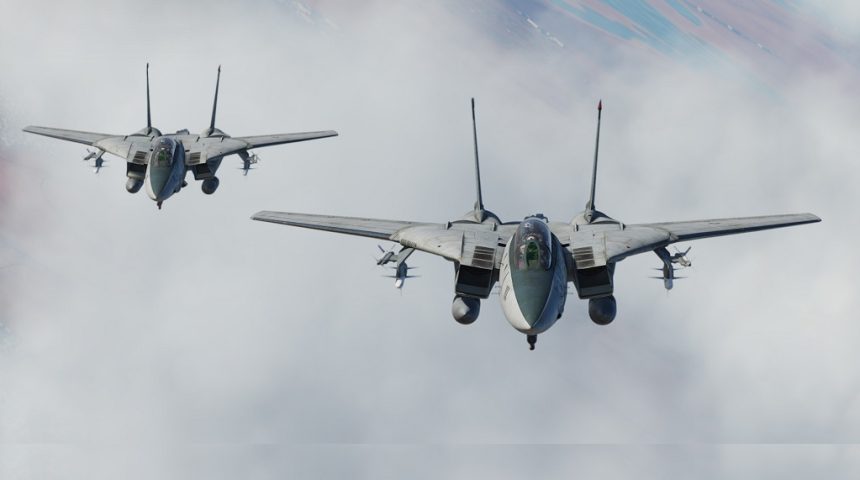For the 50th anniversary of the first flight of the legendary F-14 Tomcat, we get a look at how its legacy is still carried on by aviation enthusiasts using today’s technology.
The Grumman F-14 Tomcat flew for the first time 50 years ago, on December 21, 1970. To celebrate the half-century of life of this legendary fighter aircraft and remember its legacy, we will talk about the “Turkey” (as the aircraft would be later nicknamed) first air-to-air encounters and its first air-to-air victories. The episodes we are going to recount, however, were not the first “baptism of fire” of the F-14, as the first combat deployment of the aircraft happened in 1974, when VF-1 “Wolfpack” and VF-2 “Bounty Hunters” were deployed aboard the USS Enterprise in Vietnam to provide air cover for Operation Frequent Wind, the American evacuation of Saigon, though no air-to-air engagement were reported.
This first two air-to-air fights of the F-14 happened over the Gulf of Sidra, on the northern coast of Libya, in 1981 and 1989 respectively. In a few articles here at TheAviationist last year we talked about DCS World, a free to play combat flight simulator (that can be enriched with additional payware modules) that quickly became pretty popular among aviation enthusiasts from all around the world. Some players, using the highly anticipated F-14A/B module by Heatblur Simulations that was released last year, recreated with great detail the two air-to-air encounters with the Libyan Air Force, even including the original radio recordings from the real event.
The first engagement happened on Aug. 19, 1981. Some years earlier, in 1973, Colonel Gaddafi declared the waters below 32° 30’ territory of the Libyan Arab Republic, violating the international laws which recognize territorial waters only up to 12 miles from the coast. In response to that, the U.S. Navy initiated “Freedom of Navigation” (FON) exercises in the area. At the time the Libyan Air Force had in its inventory the MiG-23 ‘Flogger’, MiG-25 “Foxbat”, Sukhoi Su-20 ‘Fitter-C’, Su-22M ‘Fitter-J’ and Mirage F1, which were all used to launch mock attacks against the US ships and prompting intercepted without incidents.
On that day two F-14As from VF-41 “Black Aces”, “Fast Eagle 102” (BuNo 160403), flown by CDR Henry “Hank” Kleemann and LT David “DJ” Venlet, and “Fast Eagle 107” (BuNo 160390), flown by LT Lawrence “Music” Muczynski and LTJG James “Luca” Anderson), were vectored during their Combat Air Patrol (CAP) to confront two Su-22s that were launched to intercept an S-3A Viking that was orbiting just outside the internationally recognized 12-mile territorial water limit.
This time, though, one of the Fitters opened fire, launching a K-13/AA-2 “Atoll”, the Russian reverse-engineered variant of the AIM-9B Sidewinder, but missed the target. The Tomcats, under their assigned Rules of Engagement (RoE), were cleared to engage if fired upon, so they returned fire shooting down both hostile aircraft with AIM-9L Sidewinders. After it was retired from the service, Fast Eagle 102 was put on display at the Commemorative Air Force Museum in Midland, Texas. The incident reportedly inspired also the film Iron Eagle, featuring the F-16A/B Fighting Falcon. You can find more details of the engagement, including the first-hand account of the Tomcat crews, in this previous article of ours and in the video reconstructing the events here below.
In March 1986, three aircraft carriers were operating in the Gulf of Sidra. Again, an intense dogfight ensued between F-14s and MiG-23, though without any missiles being fired. Weapons were fired, however, by the other aircraft of the Carrier Air Wing against radar and surface-to-air missile sites and ships in response to numerous provocations and weapons fired by the Libyans. One month later, Operation El Dorado Canyon saw new US airstrikes in the African country.
The second air-to-air engagement of the Tomcat happened in 1989, when the USS John F. Kennedy was sailing toward the eastern Mediterranean Sea. This time the aircraft carrier was outside the Gulf of Sidra but, on January 4, two MiG-23 were detected heading north toward the battle group. Two F-14s from VF-32 “Swordsmen”, “Gipsy 207” (BuNo 159610), flown by Swordsmen skipper Commander Joseph B. Connelly and Commander Leo F. Enwright, and “Gipsy 202″ (BuNo. 159437), flown by Lieutenant Hermon C. Cook III and Lieutenant Commander Steven P. Collins, were directed to intercept the Floggers.
The four aircraft were on a collision course, heading for each other, with the Libyans countering every turn made away from them by the U.S. Navy aircraft. After the fifth “counter-turn” of the MiG-23s, it was considered a hostile intent and the Gipsy 207 opened fire with two AIM-7 Sparrows radar-guided missiles, which however missed the target. After a defensive split, Gipsy 202 launched another Sparrow, shooting down the first MiG-23. Gipsy 207 then shot down the other MiG using a Sidewinder, before returning to the USS Kennedy.
Gypsy 207 was later upgraded to the F-14D(R) (Remanufactured) configuration and, now that it has been retired, is displayed at the National Air and Space Museum. Gypsy 202, according to Wikipedia, in 2017 was reported to be one of eight F-14s currently remaining stored at the Aircraft Maintenance and Restoration Group (AMARG) facility at Davis-Monthan AFB and scheduled to be placed in an unspecified museum. You can find more details of the engagement, including the first-hand account of the Tomcat crews, in this previous article of ours and in the video reconstructing the events here below.









